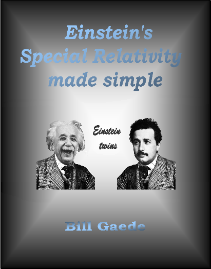
| The Standard Model of Elementary Particles of Quantum Mechanics is irrational The mechanics should have discovered by now that we cannot explain the workings of the Universe with discrete particles. |
The mathematicians may argue that the existence of each of these particles has been proven through
experiments.
We have two replies. First, in Science we don't prove. It is in religion where they prove. Proof means that
someone convinced someone of something. In Science, we don't recruit and, therefore, are not in the
business of persuading. In Science, we don't present evidence in order to sway the jury like they do in Law.
In Science, we present explanations so that the crowd understands. Whether an individual accepts the
explanation and henceforth regards it as his truth is his personal business and doesn't concern Science.
The second issue is that the mathematicians confuse proof with hypothesis. They have not proven particles.
They made an ASSUMPTION that the invisible mediators they stared at in the lab were particles.
Let's make it black and white. No one has ever seen any of these so-called particles. And here is 'proof'.
The proponent of particles simply has to illustrate ONE of his particles! Any of them! This is an objective
criterion. What does a muon look like? Please draw an electron! Does the Higgs look like an H? Most
significant, what does an atom look like? The mechanics -- the followers of Bohr and Heisenberg -- to
this day illustrate the atom that Rutherford and Bohr concocted in the early 20th century: the Planetary
Model. They use this model to explain phenomena such as ionization and electricity. At the end of their
presentation, the mechanics deny that what they just used as a model is the actual atom. It was merely
a model they borrowed to simulate the observations they just explained. To explain Quantum Leap and
covalent bonding they get rid of the Planetary Model altogether and do their presentation with the cloud
or shell model.

- Quantum has no idea what particles look like
The Quantum version of the atom relies on magic. Not only is Quantum unable to rationally justify why the
electron stays faithful to the proton, but its proposal that the ethereal orbitals of atoms interlock to form
molecules requires more than a leap of faith.
Let's clarify that we are not challenging the equations of Quantum. Likewise, we are not challenging what
researchers claimed to observe in the lab. What we are challenging are the physical interpretations that the
mathematicians have given those equations and experiments. It is the Particle Hypothesis which should be
abandoned now and forevermore. We cannot explain a single phenomenon of nature with discrete particles.

This is a cross-section of the rope model of the atom. The EM ropes converge upon an atom
from every atom in the Universe. The rope forks out at the boundary of the electron shell. The
electric thread (here marked in blue) continues straight to the center of the atom and comes
out the other end. The magnetic thread (red) curves around and together with countless other
threads forms the electron shell. It also extends outward to another atom at some point along
the shell.
from every atom in the Universe. The rope forks out at the boundary of the electron shell. The
electric thread (here marked in blue) continues straight to the center of the atom and comes
out the other end. The magnetic thread (red) curves around and together with countless other
threads forms the electron shell. It also extends outward to another atom at some point along
the shell.
- The Rope Model
What do we propose in the alternative?
Well, in order to explain action-at-a-distance you must, you absolutely MUST have an extended invisible entity.
Otherwise, you will invariably be doing wizardry. You cannot rationalize action-at-a-distance without a mediator!
The force of pull MUST be mediated by a string, rope, thread, cable, wire, chain, coaxial or some other
elongated object that stretches from here to there. The alternative is to invoke magic and spirits (i.e., the way of
Quantum Mechanics).
We propose that the extended electromagnetic rope (the mediator of light) is also the building block of atoms.
The rope forks at the surface of the atom. The electric thread continues straight to the center of the atom and
out the other end. These straight threads form the proton, an urchin-like entity that fills the core of the atom. The
magnetic thread, instead, coils around and together with countless other threads arriving from every atom in the
Universe forms the electron shell that envelopes the proton. The atom is a tiny star encapsulated within a balloon.

| < Each particle of the Standard Model of Quantum Mechanics is spherical. This doesn't tell us how the properties of the particle are related to its shape. For instance, a gluon pulls two quarks together. Is a gluon hook shaped? Is this the physical mechanism that prevents quarks from drifting apart? |
The Rope Model explains several behaviors of the atom and the neutron.
| What does an atom really look like? |
Credit: David Robison



| In the religion of Quantum Mechanics, electricity is explained as the flow of electron beads from one atom to another. |
| In order to simulate electric current, the mechanics must invoke Bohr's planetary model of the atom (i.e., orbiting beads) |
| However, in order to explain bonding in Molecular Orbital Theory, the mechanics get rid of the bead altogether and work with the 'orbitals', the REGIONS in which an electron bead may be found. |
| To simulate this part of the presentation the mechanics invoke Born's Cloud Model of the atom (i.e., balloons)! |

| Quantum Magic Illustrated How Bohr's disciples get away with murder |
.
| To comment on any of the pages in this website go to: Rational Science |

